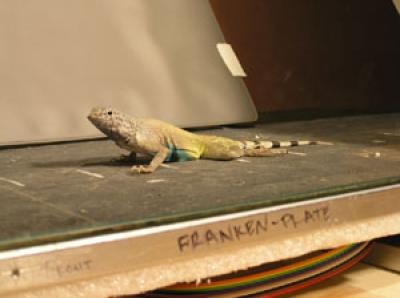As you might expect, much of the evolution of how lizards move is related to getting food.
A research team led by Ohio University doctoral student Eric McElroy tracked 18 different species of lizards as they walked or ran in order to understand how their foraging styles impact their biomechanics. The study, funded by the National Science Foundation, was featured in the April 1 edition of the Journal of Experimental Biology.
Lizards use two basic foraging techniques. In the first approach, aptly dubbed sit-and-wait, lizards spend most of their time perched in one location waiting for their prey to pass. Then, with a quick burst of speed, they run after their prey, snatching it up with their tongues.

In the other form of foraging, known as wide or active foraging, lizards move constantly but very slowly in their environment, using their chemosensory system to stalk their prey, according to the research team, which included McElroy’s adviser Stephen Reilly, professor of biological sciences, and undergraduate honors thesis student Kristin Hickey.
Although wide foraging evolved from the sit-and-wait technique, these two styles are almost opposites. Some wide foragers are on the move about 80 percent of the time while sit-and-wait foragers may move only about 10 percent of the time, said Reilly, co-author of a recent book on the topic, Lizard Ecology, published by the Cambridge University Press.
While all lizards have the ability to run, a predatory defense mechanism, the study found that sit-and-wait lizards won’t walk. Lizards that use the sit-and-wait method of foraging use running mechanics even when moving at slower speeds.
Wide foragers, however, evolved a walking gait and mechanics. They must move at slower speeds in order to use their advanced chemosensory system to locate their prey.
Foraging and locomotion are so closely linked, in fact, that three groups of wide foragers that had reverted to using the sit-and-wait technique actually lost the ability to walk, the researchers reported.
“The most interesting aspect of this research is that it demonstrates a clear link between animal behavior and functional morphology. It’s quite amazing and surprising that the behavioral diversity that everyone knows about and is inspired by is grounded in form, function and physiology,” McElroy said.
The researchers used a race track with a built-in force plate to record the forces generated by the lizards and a high-speed video camera to record each critter moving at various speeds. The scientists collected data from the force plate and analyzed the video to determine whether the lizard was using running or walking mechanics.
The study used a large, representative sample of lizards made up of 18 different species, such as skinks, iguanas and monitor lizards. This extensive study uses one of the largest data sets for center of mass mechanics, McElroy said, and is one of the few that focuses on reptiles instead of mammals.
“Everybody works with people, dogs or horses. But they’re all freaks,” Reilly said. “They’ve gone erect, they have extra joints. They are the kings of bouncing vaulting and running fast. We are working on the sprawlers.”






Comments